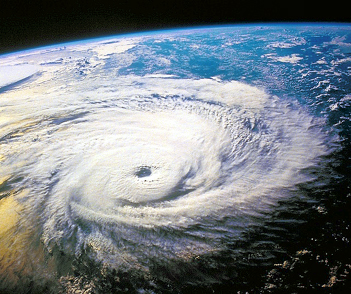Innovations
Blowin’ in the Wind: Hurricanes and the UW
by
Becky Bullock, Risk Management
Images of flooding, horizontal palm trees, and acres of damaged real estate from August's hurricane triple threat probably left most Northwesterners with a secret, guilty sense of relief. Sure, the Northwest has earthquakes, but at least we're spared the effects of hurricane damage every year!
Think again. Catastrophes around the world now send ripple effects strong enough to affect even the University's division of Financial Management.
The September 11, 2001 attacks demonstrated in a new way how interconnected our business and personal lives are with far flung locations. Disruptions in internet and cellular connections, data streams and supplies were some of the direct business effects of the attacks. Indirectly, the attacks caused financial market troughs and associated investment losses worldwide. In the insurance industry, the September 11 loss (now estimated at $35 billion) was the largest ever recorded for a single occurrence. Premium increases in the double and triple percentages were the norm in the year following the attacks, particularly in the property insurance markets. Large corporations and small businesses all felt the effects on their insurance programs.
At the UW, property insurance increased between 200-300% in the six months following September 11. Liability policies renewing in the same period increased an average of 50%, even for risks unrelated to the 9/11 loss. Although skeptics regarded this as price gouging, there was a real impact on the reinsurance markets directly responsible for the increases.
Reinsurance is a little publicized, technical insurance specialty. Most insurance companies don't have the capital (or don't want to commit their money) to write high policy limits for many customers. Instead, they buy reinsurance, which means, for example, that after the company pays $100 million in losses, the reinsurance company will pay for all remaining losses that policy year.
Reinsurance usually only kicks in for very large losses and many insurance companies spread their reinsurance among several companies to guarantee stability. Reinsurers can also reinsure their policies, leading to a web of insurers, some visible, some not, for one account. Lloyds of London is the most famous reinsurance marketplace, but markets also exist in Germany, Switzerland, the USA, Bermuda and Japan. Once reinsurance is in the picture, it's easy to see how a large loss can affect economies several continents away.
So what about the hurricanes?
Hurricanes Charley, Frances and Ivan are estimated to ultimately cause between $16-$25 billion in damage. This is a large enough loss to cause reinsurance effects. However, Florida established a catastrophe fund after Hurricane Andrew that will pay some of these losses and cushion the impact on insurers. Damages outside Florida are the wildcard- insurance will end up paying more for the losses outside hurricane-prone areas, since these losses are rare.
At the UW, property insurance for the Metropolitan Tract, Computing and Communications, and the UW's online equipment program renews November 1. The property insurance market has been 'softening' (i.e., premiums are dropping) for the last nine months. The hurricanes will probably not erase these decreases, but it's probable that the improved terms and rate decreases Risk Management was hoping for won't materialize. All thanks to Ivan the Terrible and the terrible twins, Charley and Frances.
So if your homeowner's policy increases this year, you too can thank Ivan. And go ahead and send that old dehumidifier to Florida. You could be helping yourself. |


